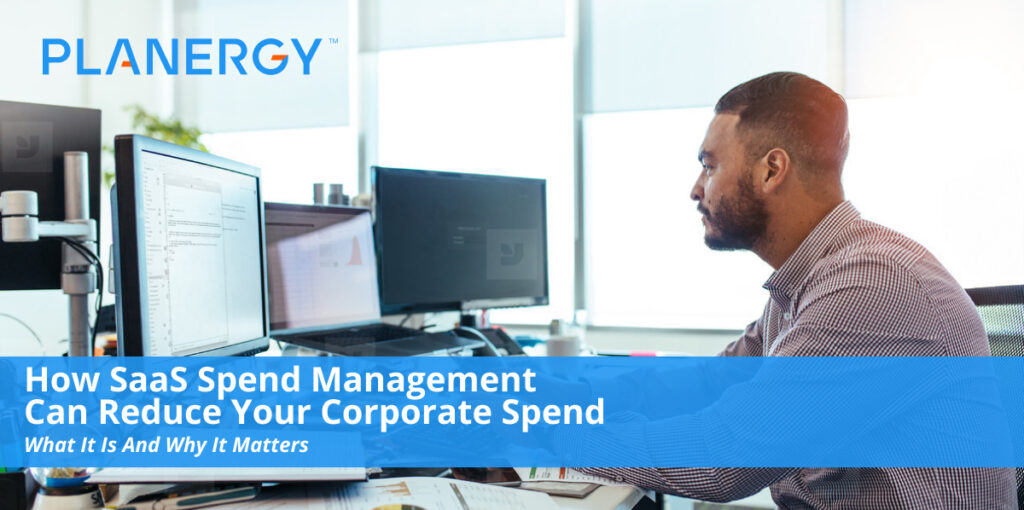SaaS options have taken over the market because they offer a lower total cost of ownership compared to on-premise solutions.
However, unless your team is getting the most out of these apps, you may not be getting all the cost savings you think you are.
That’s why SaaS spend management is such a crucial part of cost management.
Let’s take a closer look at SaaS spend management and how crafting a strategy makes sure you’re getting the maximum benefit out of all your subscriptions.
What is SaaS Spend Management?
We’ve talked about spend management before. SaaS spend management is a relatively new concept that’s based on overall spend management. Ultimately, you’re trying to get the most out of your budget.
So yes, you can spend money on an expensive SaaS solution, but only if it provides enough benefit to really justify the expense.
You do still have to control how much you’re spending on these applications overall.
Using several smaller ones, or having a ton of licenses for a variety of solutions adds up quickly. Stakeholders need to make sure they are only spending money on the subscriptions that are worth the money.
Why Do You Need SaaS Spend Management?
It seems there are more SaaS solutions popping onto the market every day. And small companies – those with up to 50 employees – find that they are using anywhere between 25 and 50 SaaS apps.
Companies with more than 250 employees easily use more than 100 applications.
That’s a lot. So it begs the questions:
- Are the staff actually using all of the apps?
- Is there any overlap among apps? For instance, are some people using Zoom, while others are using WebEx? Are some using Canva, while others are using Crello or Adobe?
- Are there any orphaned apps? These are apps without clear owners or proof that people are actually using them.
Controlling SaaS Spend
As the number of apps companies use continues to grow, your business needs an effective way to manage what they’re spending on subscriptions. Here are three ways you can do that.
Track Applications in a Spreadsheet
One SaaS spend management method is to track your applications in a spreadsheet.
Honestly, the only advantage of this method is that tracking everything on a spreadsheet is better than taking no action at all.
There are, however, multiple disadvantages to using this approach for your SaaS spend management.
- You will need to manually enter the data which increases error potential.
- Your spreadsheet won’t update automatically so you won’t have any idea when new subscriptions are added or changes have been made to an existing subscription.
- You have to track a variety of metrics within a single spreadsheet including the number of seats, cost of the subscription, who owns the app, renewal dates, compliance status, etc. You need to consider the processes related to onboarding, privacy, and security.
Mistakes in this approach could result in an inaccurate picture of your true SaaS subscription. by combining all of them, you’re looking at situations that could easily become overly complex and muddled.
Track the Number of Licenses You Have
You can invest in saas management software to track the number of licenses you have for any of your SaaS subscriptions.
That’s definitely an improvement from the spreadsheet method because the software is automated and keeps track of when new licenses are added or removed.
However, there are still some drawbacks to tracking only your licenses. By tracking only your license volume, you can’t tell how many people are using the app.
You also can’t determine if employees are taking advantage of all of the features or only using some of them. This approach doesn’t tell you what kind of value you’re getting out of a service and whether it’s worth continuing to use.
Measure User Engagement
The final, and best option, is to measure user engagement.
What is User Engagement? Why Does it Matter?
User engagement refers to how users interact with a product or service. When an employee is engaged with the app, the person spends a great deal of time and the app and the floors all of its features.
The most engaged users figure out how to get the most from the app to provide the greatest value in their work.
User engagement matters because it indicates how much someone is using an app.
Decision-makers in your organization don’t want to waste money on apps that people aren’t using, and if they are using them, they don’t want to waste money on teachers that aren’t being used.
Decision-makers want to see a return on investment and by measuring user engagement, is easy to determine which SaaS subscription are providing the most value and ROI.
The more organized you are, the better off you’ll be.
How to Start Decreasing SaaS Costs
Reducing the amount of money you spend on SaaS software provides savings for you both in the short-term and long-term.
You can generate savings by identifying your current sources of unnecessary expenses, getting the right number of licenses to meet your current user needs, and building a strong rationalization process to justify each application used within the organization.
You cannot manage what you cannot identify so you first have to discover the SaaS applications the organization maintains. You can do this with a thorough analysis of all financial transactions.
Ideally, your needs to include both in accounts payable or purchase orders, as well as any transactions that are created in expense categories such as corporate credit cards, employee expense reports, and procurement cards.
A procurement management platform like PLANERGY can help provide real-time data.
Next, move to finding and categorizing all SaaS applications the company is spending money on, whether they are regularly used, or valuable, or not.
You want to get a clear picture of what the current spending is, along with any potential commitments because of renewals.
That means looking at about a year’s worth of transaction data. And if you don’t source the data from accounts payable and your expense system, then you may not get the full picture.
With all this in mind, you should map out each cost detail for every application. You can get the majority of this information from the original contract or agreement.
If that’s not available, you can turn to purchase orders, invoices, or any other available billing documentation. Look for shadow IT issues – things that are used without the IT department’s approval.
If you don’t want to pay for a SaaS management platform or SaaS spend management software like Zylo, Alpin, or Torii, which surprise, is also a SaaS, you need some information to build a system of record for all your software subscriptions.
If you want help specifically with the cloud spend optimization part, not just keeping track of the SaaS subscriptions, then you can use something like Binadox or SaaSLicense to help you learn more about the costs and usage in your organization.
Other options include Intello, Blissfully, Bettercloud, Servicenow, and Flexera. These Saas discovery platforms can help you and your IT team spot overspending and use of unapproved applications. It can also help your procurement team when it comes to sourcing the things your company needs.
You need:
Basic Application Info
- Application title and supplier name
- Primary use category and specific function for the organization. What kind of SaaS usage are you getting from this application? Are you paying for Slack when using something like Skype could be enough?
Cost and Spend Details
- Total contract value, including all pricing data, platform fees and implementation fees if applicable
- Billing frequency
- Payment method
- Any billable consumption metrics or billing units such as storage limit caps, envelopes, contact list sizes, or maximum meeting
Ownership Information
- The business unit, department, and team
- Cost center
- Specific employee owner
Licenses, Entitlements, and Features
- Total number of licenses purchased
- Number of licenses under each plan type (e.g., basic vs. premium)
- Per-unit license fees
- Planned future purchases
Term and Renewal Information
- Agreement start date
- Renewal date
- Notification period
Ways to Achieve Cost Savings
Look for redundancies. Make sure the whole company is using either Zoom or WebEx, so you’re only focused on SaaS spending with one app instead of two.
Empower your team by asking them which workflows and automation they feel are best for their work. If you find that most people prefer Zoom, then stick with that rather than forcing everyone to switch to WebEx.
Once you remove redundancies, standardize and document the approved tools. If you find options outside of the approved tools, get rid of them.
Look at renewal dates on contracts. Priortize a keep or delete system for any applications with renewal dates that are coming up.
This will prevent automatic renewals from locking the business in contracts that are no longer wanted or needed.
Cancel any and all unnecessary applications. Get rid of anything that doesn’t make a huge difference in your business operations or pass your rationalization process. Give the vendor appropriate notice when necessary, using the appropriate method.
Continue to monitor and discover SaaS applications to optimize functionality while keeping your spend under control. Keep in touch with Human Resources so you can get rid of applications you don’t need anymore because an employee leaves.
PLANERGY is a SaaS-based program that can bring great value to your organization by tracking purchases, budgets, and your accounts payable workflow automation.




